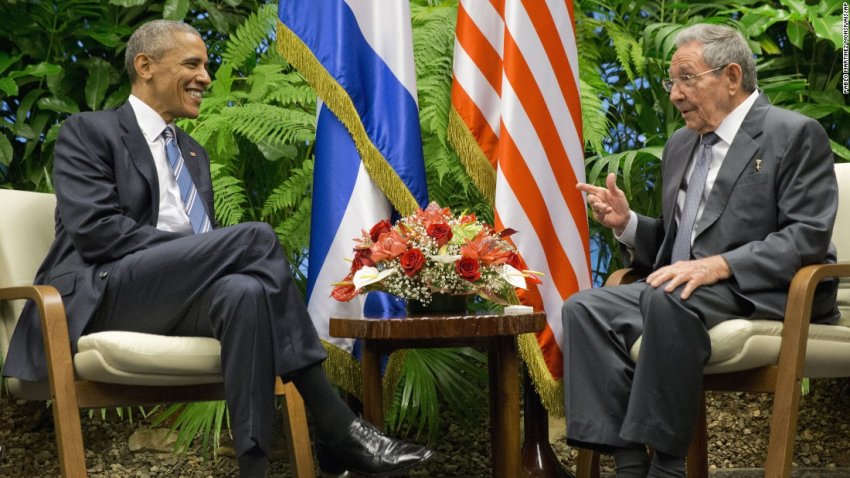
Cuba-US Relations: Obama & Beyond
Arnold August
Fernwood Publications, 2017
What’s the fate of Cuba in the age of Trump? It is not an easy question to unravel, but Canadian author and journalist Arnold August provides some answers in his latest book, Cuba-US Relations: Obama and Beyond.
One of the English language’s most renowned Cuba watchers, August’s writings have long been a staple for leftists looking for nuanced, careful analysis of Cuban politics and current affairs.
In his latest work, August draws on decades of research and on-the-ground experience in Cuba to contextualise the island nation’s successes (and failures) as it navigates through a changed world — one that may have seemed unimaginable when August wrote Cuba and Its Neighbours: Democracy in Motion in 2013.
Indeed, it’s hard to discuss Obama and Beyond without looking back at Democracy in Motion. In many ways, Obama and Beyond is its spiritual sequel. Democracy in Motion was a cautiously optimistic tour of a region exploding with new ideas and democracies.
It looked at Latin America’s then-flourishing Pink Tide – a broad movement of progressives winning power from Venezuela to Bolivia, Ecuador and Brazil. At the heart of the Pink Tide, August argued, was Cuba. For decades, Cuba was the sole outpost of socialism in the Western Hemisphere, and it is impossible to overstate its significance as a symbol of defiance in Latin America.
For August, Cuba was an indispensable inspiration for the Pink Tide — not a leader or model, per se, but rather a stubborn symbol of resistance.
The optimism only grew in late 2014/2015, when then US President Barack Obama announced his administration’s intention to roll back the decades-old US blockade against Cuba and re-establish normal diplomatic relations with its island neighbour. Finally, Cuba’s long struggle for freedom from the crippling blockade was close at hand.
Today, that’s all history. The Pink Tide that was at its height in 2013 is today in crisis. Whether this crisis is terminal or not, it poses questions about where this new regional shift leaves Cuba. And what is the impact on US policy towards Cuba of the rise to presidency of Donald Trump?
August approaches these big questions with caution and careful analysis. Nothing is sugar-coated, but he is not a defeatist, either.
Instead, August presents a realistic understanding of Cuba’s current political situation. It is a sobering look at how Obama-era and Trump’s Cuba policies aren’t quite as different as they might initially seem.
Obama and Beyond is likewise presented in a manner that’s both accessible and dense at the same time. Despite his academic credentials, August has never been one for technical jargon. Instead, he presents his analysis with a frank, straight-forward tone that’s as informative as it is easy to read.
Having said that, Obama and Beyond isn’t always a laid-back read. When necessary, August is happy to dive into the numbers and deep data to substantiate his arguments. He knows Cuba’s economy like the back of his hand, and navigates its complicated political system like it is his own home. After all, this depth of knowledge is what gives August his ability to draw conclusions about Cuba’s trajectory with such pinpoint precision.
Obama and Beyond is not necessarily for everyone. The book draws heavily on August’s published work from the past decade or so, and thus largely reads as a compilation piece. This means the most avid of Cuba watchers will probably already have some familiarity with much of the material August brings to bear, along with his overall argument.
For me, it served as a useful refresher, and it was very useful to see August’s deep and complex view of Cuba presented in a single, flowing narrative drawn from years of work. However, I can see how some Cuba experts may feel inclined to skip some of the earlier contextualisation in favour of jumping directly to August’s most contemporary arguments later in the book.
Either way, this format is well-suited to readers looking for a crash course in modern Cuba. In terms of sheer content, you definitely get your money’s worth.
Overall, I would recommend Obama and Beyond to anyone trying to develop a comprehensive understanding of modern Cuba and its political challenges in the international arena.
If you’ve never studied Cuba closely, then August is a critical thinker’s best friend. If, like me, you have a general understanding of Cuba but have struggled to keep up with the flurry of developments over the past few years, then Obama and Beyond is an indispensable companion.
Finally, for solidarity activists, August’s work simply has to be considered mandatory reading. In this sense Obama and Beyond can be considered a primer for activists to not only understand Cuba, but also learn from that nation’s long struggle for revolution.
Like the article? Subscribe to Green Left now! You can also like us on Facebook and follow us on Twitter.